Change Management Plan Report: Employee Turnover and Kotter's Model
VerifiedAdded on 2020/07/22
|11
|3269
|52
Report
AI Summary
This report provides an in-depth analysis of employee turnover, a significant problem for many organizations. It begins with an introduction to organizational change and change management, highlighting the impact of employee turnover on business success. The report then outlines a change management plan based on Kotter's 8-stage change model, offering a structured approach to address and reduce employee turnover. The plan includes strategies for increasing urgency, forming powerful guiding coalitions, creating a vision for change, communicating the vision, removing obstacles, generating short-term wins, consolidating gains, and anchoring new approaches. The report also discusses relevant Australian laws, policies, and regulations related to employee relations, providing a comprehensive understanding of the challenges and solutions in managing employee turnover and fostering a positive work environment.
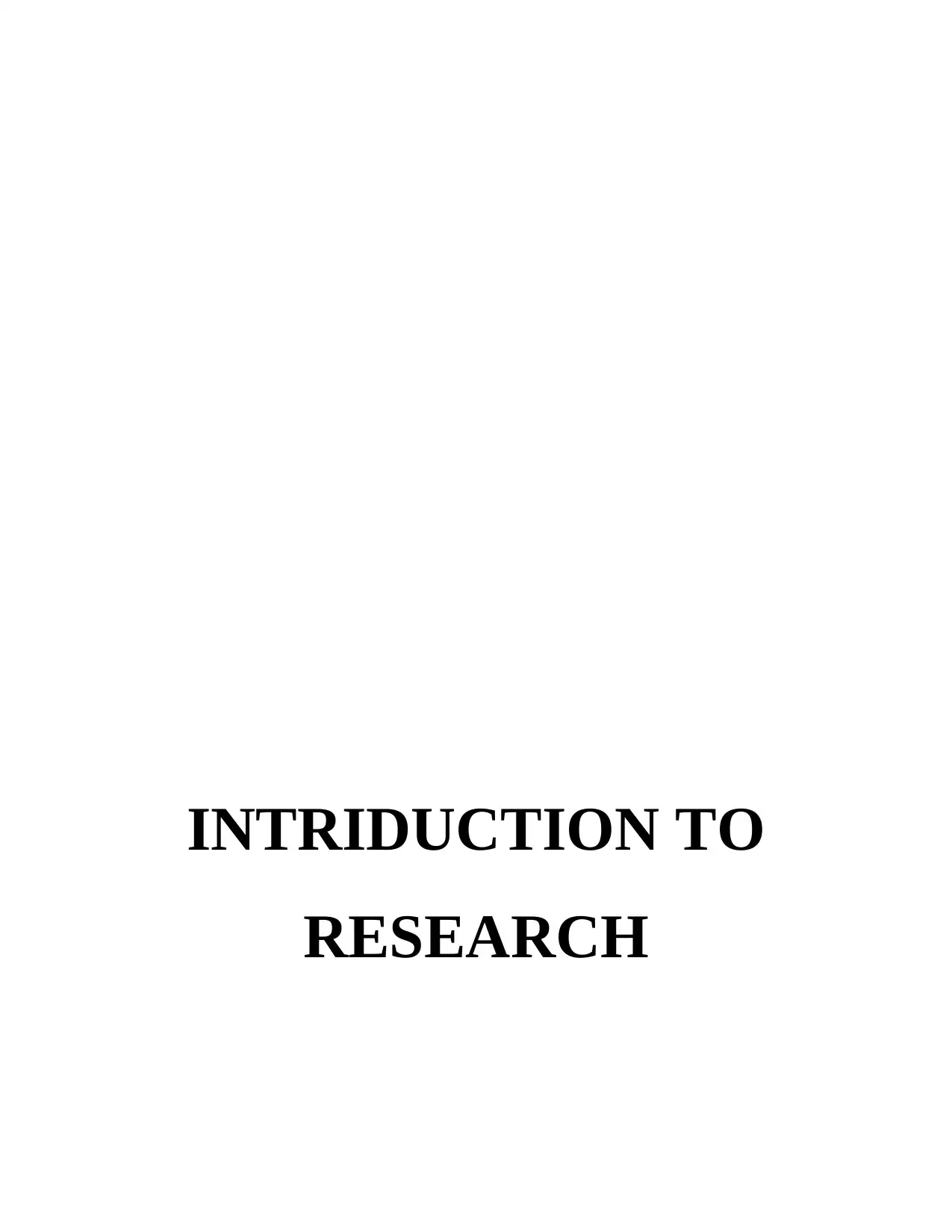
INTRIDUCTION TO
RESEARCH
RESEARCH
Paraphrase This Document
Need a fresh take? Get an instant paraphrase of this document with our AI Paraphraser

Table of Contents
..........................................................................................................................................................8
..........................................................................................................................................................8
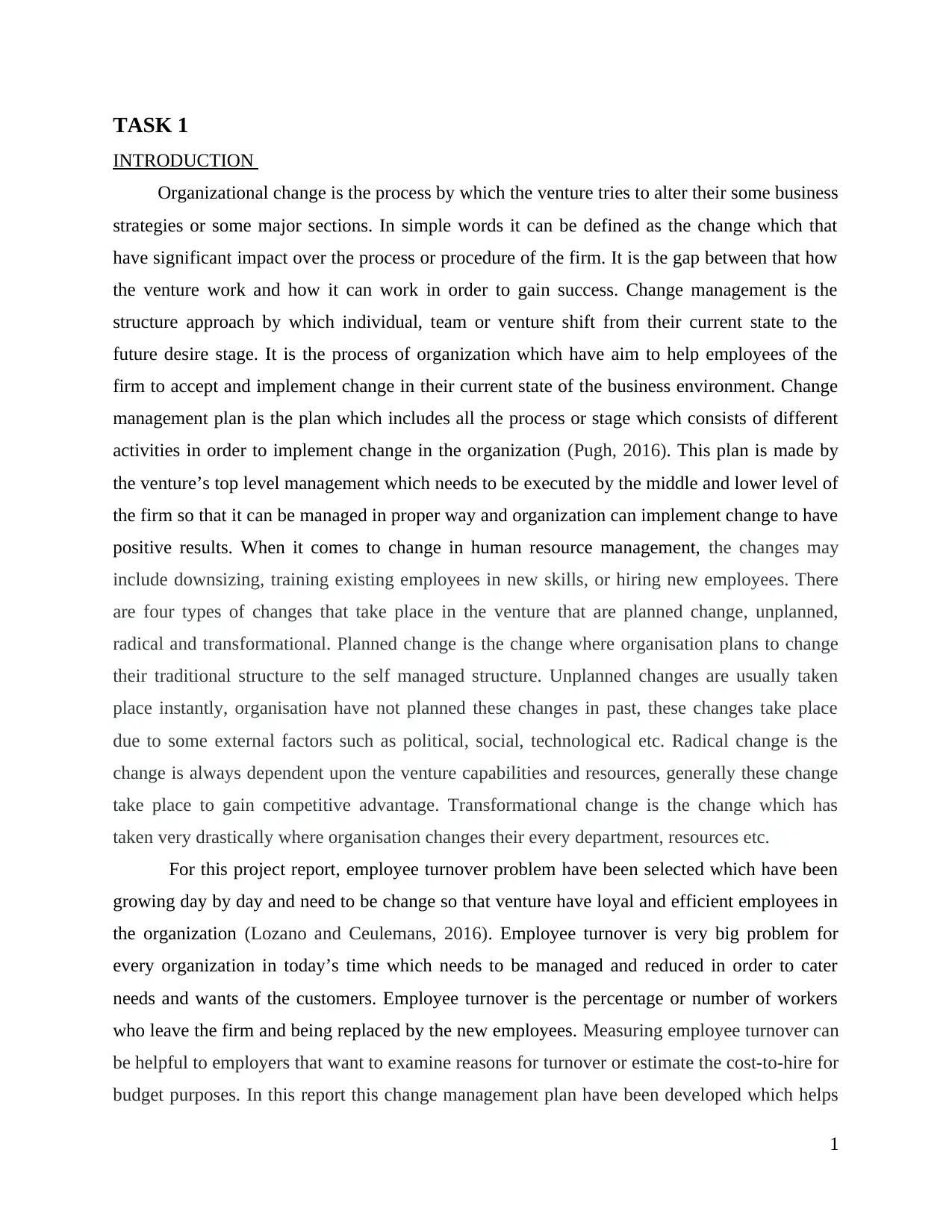
TASK 1
INTRODUCTION
Organizational change is the process by which the venture tries to alter their some business
strategies or some major sections. In simple words it can be defined as the change which that
have significant impact over the process or procedure of the firm. It is the gap between that how
the venture work and how it can work in order to gain success. Change management is the
structure approach by which individual, team or venture shift from their current state to the
future desire stage. It is the process of organization which have aim to help employees of the
firm to accept and implement change in their current state of the business environment. Change
management plan is the plan which includes all the process or stage which consists of different
activities in order to implement change in the organization (Pugh, 2016). This plan is made by
the venture’s top level management which needs to be executed by the middle and lower level of
the firm so that it can be managed in proper way and organization can implement change to have
positive results. When it comes to change in human resource management, the changes may
include downsizing, training existing employees in new skills, or hiring new employees. There
are four types of changes that take place in the venture that are planned change, unplanned,
radical and transformational. Planned change is the change where organisation plans to change
their traditional structure to the self managed structure. Unplanned changes are usually taken
place instantly, organisation have not planned these changes in past, these changes take place
due to some external factors such as political, social, technological etc. Radical change is the
change is always dependent upon the venture capabilities and resources, generally these change
take place to gain competitive advantage. Transformational change is the change which has
taken very drastically where organisation changes their every department, resources etc.
For this project report, employee turnover problem have been selected which have been
growing day by day and need to be change so that venture have loyal and efficient employees in
the organization (Lozano and Ceulemans, 2016). Employee turnover is very big problem for
every organization in today’s time which needs to be managed and reduced in order to cater
needs and wants of the customers. Employee turnover is the percentage or number of workers
who leave the firm and being replaced by the new employees. Measuring employee turnover can
be helpful to employers that want to examine reasons for turnover or estimate the cost-to-hire for
budget purposes. In this report this change management plan have been developed which helps
1
INTRODUCTION
Organizational change is the process by which the venture tries to alter their some business
strategies or some major sections. In simple words it can be defined as the change which that
have significant impact over the process or procedure of the firm. It is the gap between that how
the venture work and how it can work in order to gain success. Change management is the
structure approach by which individual, team or venture shift from their current state to the
future desire stage. It is the process of organization which have aim to help employees of the
firm to accept and implement change in their current state of the business environment. Change
management plan is the plan which includes all the process or stage which consists of different
activities in order to implement change in the organization (Pugh, 2016). This plan is made by
the venture’s top level management which needs to be executed by the middle and lower level of
the firm so that it can be managed in proper way and organization can implement change to have
positive results. When it comes to change in human resource management, the changes may
include downsizing, training existing employees in new skills, or hiring new employees. There
are four types of changes that take place in the venture that are planned change, unplanned,
radical and transformational. Planned change is the change where organisation plans to change
their traditional structure to the self managed structure. Unplanned changes are usually taken
place instantly, organisation have not planned these changes in past, these changes take place
due to some external factors such as political, social, technological etc. Radical change is the
change is always dependent upon the venture capabilities and resources, generally these change
take place to gain competitive advantage. Transformational change is the change which has
taken very drastically where organisation changes their every department, resources etc.
For this project report, employee turnover problem have been selected which have been
growing day by day and need to be change so that venture have loyal and efficient employees in
the organization (Lozano and Ceulemans, 2016). Employee turnover is very big problem for
every organization in today’s time which needs to be managed and reduced in order to cater
needs and wants of the customers. Employee turnover is the percentage or number of workers
who leave the firm and being replaced by the new employees. Measuring employee turnover can
be helpful to employers that want to examine reasons for turnover or estimate the cost-to-hire for
budget purposes. In this report this change management plan have been developed which helps
1
⊘ This is a preview!⊘
Do you want full access?
Subscribe today to unlock all pages.

Trusted by 1+ million students worldwide
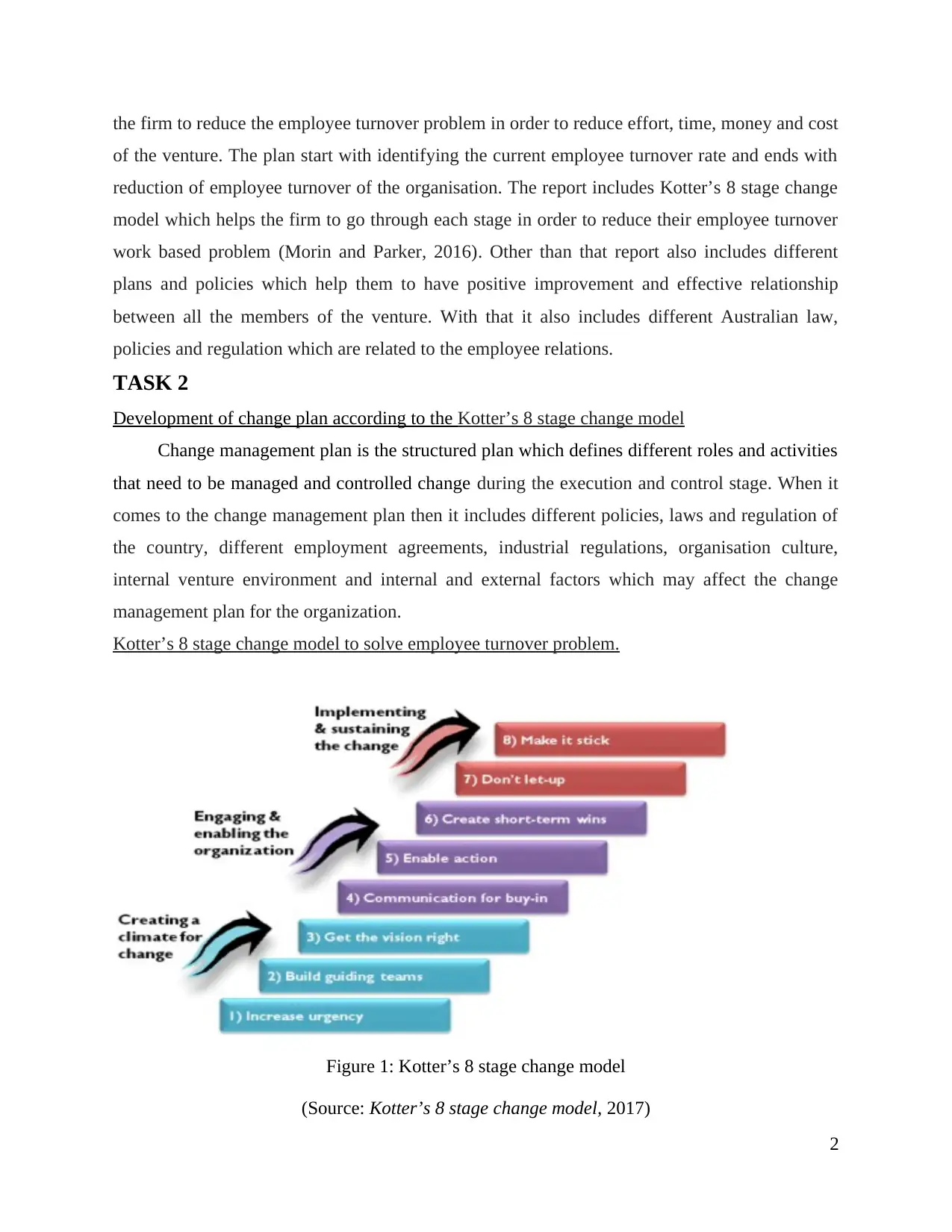
the firm to reduce the employee turnover problem in order to reduce effort, time, money and cost
of the venture. The plan start with identifying the current employee turnover rate and ends with
reduction of employee turnover of the organisation. The report includes Kotter’s 8 stage change
model which helps the firm to go through each stage in order to reduce their employee turnover
work based problem (Morin and Parker, 2016). Other than that report also includes different
plans and policies which help them to have positive improvement and effective relationship
between all the members of the venture. With that it also includes different Australian law,
policies and regulation which are related to the employee relations.
TASK 2
Development of change plan according to the Kotter’s 8 stage change model
Change management plan is the structured plan which defines different roles and activities
that need to be managed and controlled change during the execution and control stage. When it
comes to the change management plan then it includes different policies, laws and regulation of
the country, different employment agreements, industrial regulations, organisation culture,
internal venture environment and internal and external factors which may affect the change
management plan for the organization.
Kotter’s 8 stage change model to solve employee turnover problem.
Figure 1: Kotter’s 8 stage change model
(Source: Kotter’s 8 stage change model, 2017)
2
of the venture. The plan start with identifying the current employee turnover rate and ends with
reduction of employee turnover of the organisation. The report includes Kotter’s 8 stage change
model which helps the firm to go through each stage in order to reduce their employee turnover
work based problem (Morin and Parker, 2016). Other than that report also includes different
plans and policies which help them to have positive improvement and effective relationship
between all the members of the venture. With that it also includes different Australian law,
policies and regulation which are related to the employee relations.
TASK 2
Development of change plan according to the Kotter’s 8 stage change model
Change management plan is the structured plan which defines different roles and activities
that need to be managed and controlled change during the execution and control stage. When it
comes to the change management plan then it includes different policies, laws and regulation of
the country, different employment agreements, industrial regulations, organisation culture,
internal venture environment and internal and external factors which may affect the change
management plan for the organization.
Kotter’s 8 stage change model to solve employee turnover problem.
Figure 1: Kotter’s 8 stage change model
(Source: Kotter’s 8 stage change model, 2017)
2
Paraphrase This Document
Need a fresh take? Get an instant paraphrase of this document with our AI Paraphraser
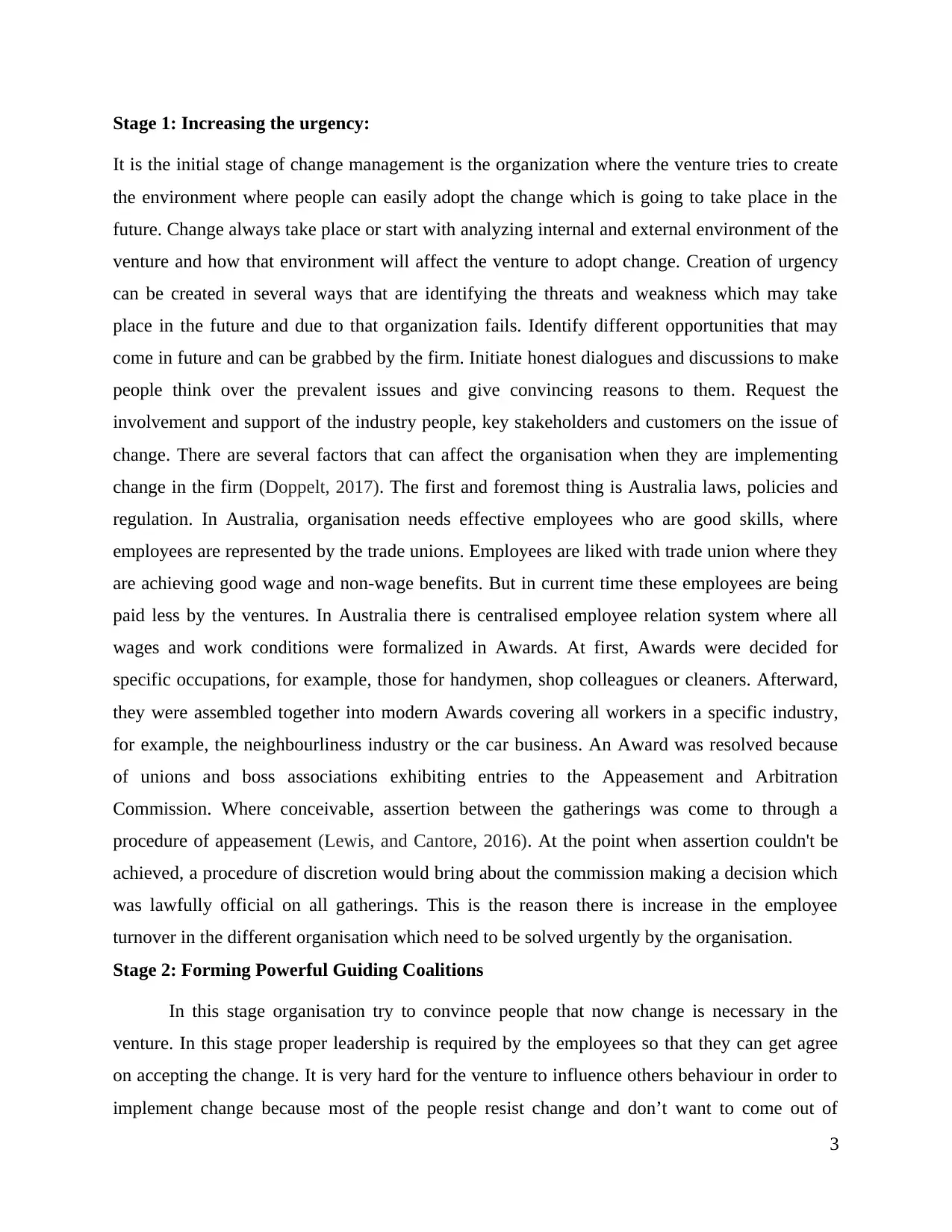
Stage 1: Increasing the urgency:
It is the initial stage of change management is the organization where the venture tries to create
the environment where people can easily adopt the change which is going to take place in the
future. Change always take place or start with analyzing internal and external environment of the
venture and how that environment will affect the venture to adopt change. Creation of urgency
can be created in several ways that are identifying the threats and weakness which may take
place in the future and due to that organization fails. Identify different opportunities that may
come in future and can be grabbed by the firm. Initiate honest dialogues and discussions to make
people think over the prevalent issues and give convincing reasons to them. Request the
involvement and support of the industry people, key stakeholders and customers on the issue of
change. There are several factors that can affect the organisation when they are implementing
change in the firm (Doppelt, 2017). The first and foremost thing is Australia laws, policies and
regulation. In Australia, organisation needs effective employees who are good skills, where
employees are represented by the trade unions. Employees are liked with trade union where they
are achieving good wage and non-wage benefits. But in current time these employees are being
paid less by the ventures. In Australia there is centralised employee relation system where all
wages and work conditions were formalized in Awards. At first, Awards were decided for
specific occupations, for example, those for handymen, shop colleagues or cleaners. Afterward,
they were assembled together into modern Awards covering all workers in a specific industry,
for example, the neighbourliness industry or the car business. An Award was resolved because
of unions and boss associations exhibiting entries to the Appeasement and Arbitration
Commission. Where conceivable, assertion between the gatherings was come to through a
procedure of appeasement (Lewis, and Cantore, 2016). At the point when assertion couldn't be
achieved, a procedure of discretion would bring about the commission making a decision which
was lawfully official on all gatherings. This is the reason there is increase in the employee
turnover in the different organisation which need to be solved urgently by the organisation.
Stage 2: Forming Powerful Guiding Coalitions
In this stage organisation try to convince people that now change is necessary in the
venture. In this stage proper leadership is required by the employees so that they can get agree
on accepting the change. It is very hard for the venture to influence others behaviour in order to
implement change because most of the people resist change and don’t want to come out of
3
It is the initial stage of change management is the organization where the venture tries to create
the environment where people can easily adopt the change which is going to take place in the
future. Change always take place or start with analyzing internal and external environment of the
venture and how that environment will affect the venture to adopt change. Creation of urgency
can be created in several ways that are identifying the threats and weakness which may take
place in the future and due to that organization fails. Identify different opportunities that may
come in future and can be grabbed by the firm. Initiate honest dialogues and discussions to make
people think over the prevalent issues and give convincing reasons to them. Request the
involvement and support of the industry people, key stakeholders and customers on the issue of
change. There are several factors that can affect the organisation when they are implementing
change in the firm (Doppelt, 2017). The first and foremost thing is Australia laws, policies and
regulation. In Australia, organisation needs effective employees who are good skills, where
employees are represented by the trade unions. Employees are liked with trade union where they
are achieving good wage and non-wage benefits. But in current time these employees are being
paid less by the ventures. In Australia there is centralised employee relation system where all
wages and work conditions were formalized in Awards. At first, Awards were decided for
specific occupations, for example, those for handymen, shop colleagues or cleaners. Afterward,
they were assembled together into modern Awards covering all workers in a specific industry,
for example, the neighbourliness industry or the car business. An Award was resolved because
of unions and boss associations exhibiting entries to the Appeasement and Arbitration
Commission. Where conceivable, assertion between the gatherings was come to through a
procedure of appeasement (Lewis, and Cantore, 2016). At the point when assertion couldn't be
achieved, a procedure of discretion would bring about the commission making a decision which
was lawfully official on all gatherings. This is the reason there is increase in the employee
turnover in the different organisation which need to be solved urgently by the organisation.
Stage 2: Forming Powerful Guiding Coalitions
In this stage organisation try to convince people that now change is necessary in the
venture. In this stage proper leadership is required by the employees so that they can get agree
on accepting the change. It is very hard for the venture to influence others behaviour in order to
implement change because most of the people resist change and don’t want to come out of
3
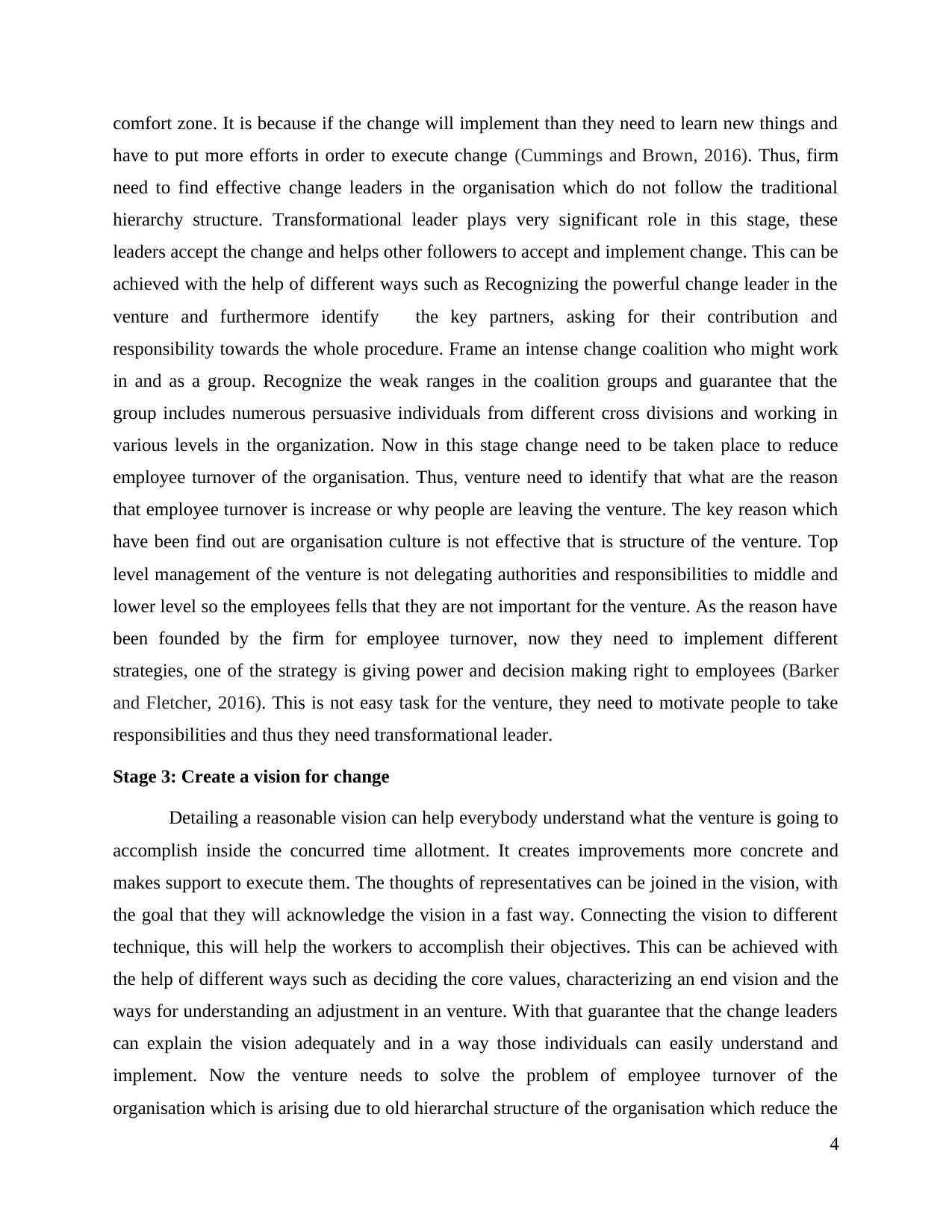
comfort zone. It is because if the change will implement than they need to learn new things and
have to put more efforts in order to execute change (Cummings and Brown, 2016). Thus, firm
need to find effective change leaders in the organisation which do not follow the traditional
hierarchy structure. Transformational leader plays very significant role in this stage, these
leaders accept the change and helps other followers to accept and implement change. This can be
achieved with the help of different ways such as Recognizing the powerful change leader in the
venture and furthermore identify the key partners, asking for their contribution and
responsibility towards the whole procedure. Frame an intense change coalition who might work
in and as a group. Recognize the weak ranges in the coalition groups and guarantee that the
group includes numerous persuasive individuals from different cross divisions and working in
various levels in the organization. Now in this stage change need to be taken place to reduce
employee turnover of the organisation. Thus, venture need to identify that what are the reason
that employee turnover is increase or why people are leaving the venture. The key reason which
have been find out are organisation culture is not effective that is structure of the venture. Top
level management of the venture is not delegating authorities and responsibilities to middle and
lower level so the employees fells that they are not important for the venture. As the reason have
been founded by the firm for employee turnover, now they need to implement different
strategies, one of the strategy is giving power and decision making right to employees (Barker
and Fletcher, 2016). This is not easy task for the venture, they need to motivate people to take
responsibilities and thus they need transformational leader.
Stage 3: Create a vision for change
Detailing a reasonable vision can help everybody understand what the venture is going to
accomplish inside the concurred time allotment. It creates improvements more concrete and
makes support to execute them. The thoughts of representatives can be joined in the vision, with
the goal that they will acknowledge the vision in a fast way. Connecting the vision to different
technique, this will help the workers to accomplish their objectives. This can be achieved with
the help of different ways such as deciding the core values, characterizing an end vision and the
ways for understanding an adjustment in an venture. With that guarantee that the change leaders
can explain the vision adequately and in a way those individuals can easily understand and
implement. Now the venture needs to solve the problem of employee turnover of the
organisation which is arising due to old hierarchal structure of the organisation which reduce the
4
have to put more efforts in order to execute change (Cummings and Brown, 2016). Thus, firm
need to find effective change leaders in the organisation which do not follow the traditional
hierarchy structure. Transformational leader plays very significant role in this stage, these
leaders accept the change and helps other followers to accept and implement change. This can be
achieved with the help of different ways such as Recognizing the powerful change leader in the
venture and furthermore identify the key partners, asking for their contribution and
responsibility towards the whole procedure. Frame an intense change coalition who might work
in and as a group. Recognize the weak ranges in the coalition groups and guarantee that the
group includes numerous persuasive individuals from different cross divisions and working in
various levels in the organization. Now in this stage change need to be taken place to reduce
employee turnover of the organisation. Thus, venture need to identify that what are the reason
that employee turnover is increase or why people are leaving the venture. The key reason which
have been find out are organisation culture is not effective that is structure of the venture. Top
level management of the venture is not delegating authorities and responsibilities to middle and
lower level so the employees fells that they are not important for the venture. As the reason have
been founded by the firm for employee turnover, now they need to implement different
strategies, one of the strategy is giving power and decision making right to employees (Barker
and Fletcher, 2016). This is not easy task for the venture, they need to motivate people to take
responsibilities and thus they need transformational leader.
Stage 3: Create a vision for change
Detailing a reasonable vision can help everybody understand what the venture is going to
accomplish inside the concurred time allotment. It creates improvements more concrete and
makes support to execute them. The thoughts of representatives can be joined in the vision, with
the goal that they will acknowledge the vision in a fast way. Connecting the vision to different
technique, this will help the workers to accomplish their objectives. This can be achieved with
the help of different ways such as deciding the core values, characterizing an end vision and the
ways for understanding an adjustment in an venture. With that guarantee that the change leaders
can explain the vision adequately and in a way those individuals can easily understand and
implement. Now the venture needs to solve the problem of employee turnover of the
organisation which is arising due to old hierarchal structure of the organisation which reduce the
4
⊘ This is a preview!⊘
Do you want full access?
Subscribe today to unlock all pages.

Trusted by 1+ million students worldwide
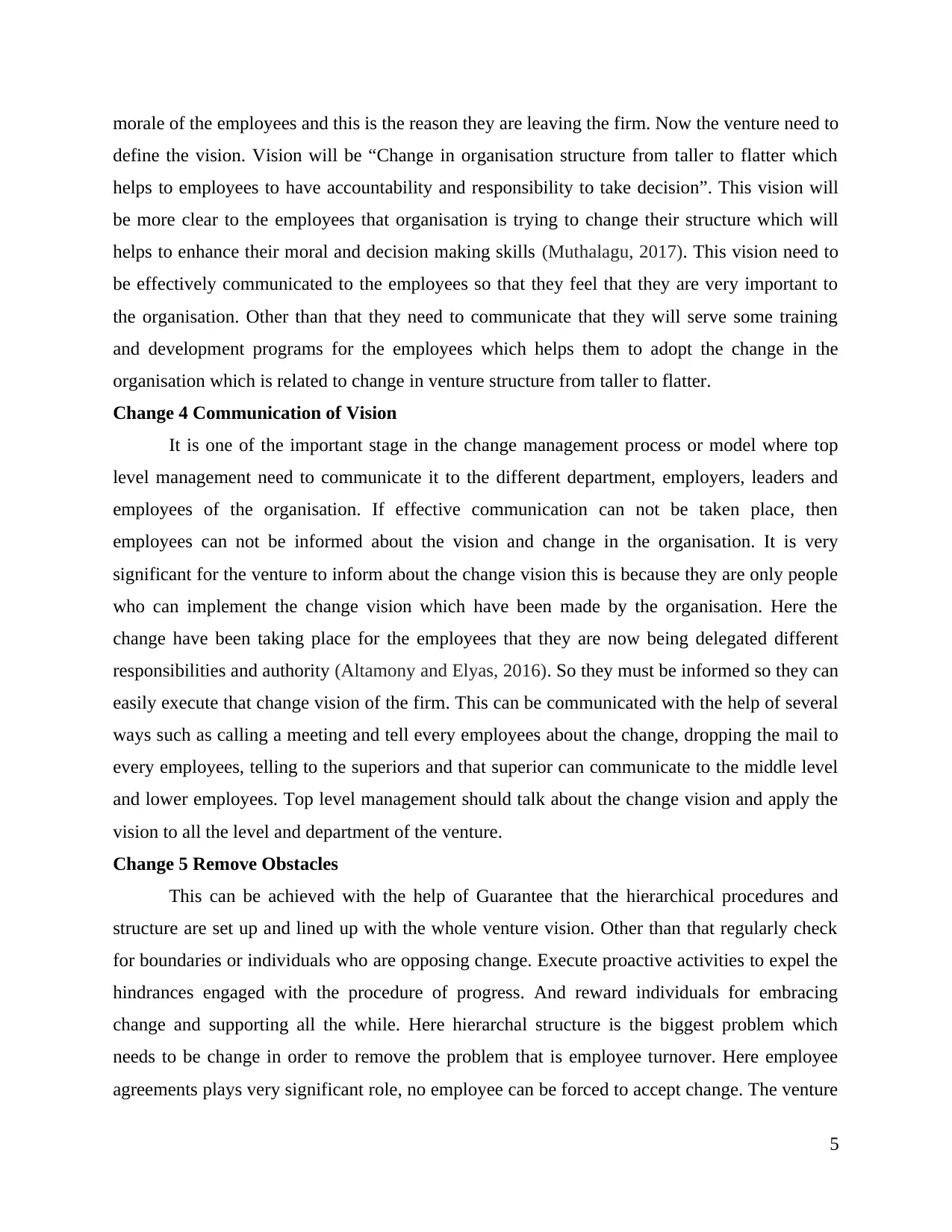
morale of the employees and this is the reason they are leaving the firm. Now the venture need to
define the vision. Vision will be “Change in organisation structure from taller to flatter which
helps to employees to have accountability and responsibility to take decision”. This vision will
be more clear to the employees that organisation is trying to change their structure which will
helps to enhance their moral and decision making skills (Muthalagu, 2017). This vision need to
be effectively communicated to the employees so that they feel that they are very important to
the organisation. Other than that they need to communicate that they will serve some training
and development programs for the employees which helps them to adopt the change in the
organisation which is related to change in venture structure from taller to flatter.
Change 4 Communication of Vision
It is one of the important stage in the change management process or model where top
level management need to communicate it to the different department, employers, leaders and
employees of the organisation. If effective communication can not be taken place, then
employees can not be informed about the vision and change in the organisation. It is very
significant for the venture to inform about the change vision this is because they are only people
who can implement the change vision which have been made by the organisation. Here the
change have been taking place for the employees that they are now being delegated different
responsibilities and authority (Altamony and Elyas, 2016). So they must be informed so they can
easily execute that change vision of the firm. This can be communicated with the help of several
ways such as calling a meeting and tell every employees about the change, dropping the mail to
every employees, telling to the superiors and that superior can communicate to the middle level
and lower employees. Top level management should talk about the change vision and apply the
vision to all the level and department of the venture.
Change 5 Remove Obstacles
This can be achieved with the help of Guarantee that the hierarchical procedures and
structure are set up and lined up with the whole venture vision. Other than that regularly check
for boundaries or individuals who are opposing change. Execute proactive activities to expel the
hindrances engaged with the procedure of progress. And reward individuals for embracing
change and supporting all the while. Here hierarchal structure is the biggest problem which
needs to be change in order to remove the problem that is employee turnover. Here employee
agreements plays very significant role, no employee can be forced to accept change. The venture
5
define the vision. Vision will be “Change in organisation structure from taller to flatter which
helps to employees to have accountability and responsibility to take decision”. This vision will
be more clear to the employees that organisation is trying to change their structure which will
helps to enhance their moral and decision making skills (Muthalagu, 2017). This vision need to
be effectively communicated to the employees so that they feel that they are very important to
the organisation. Other than that they need to communicate that they will serve some training
and development programs for the employees which helps them to adopt the change in the
organisation which is related to change in venture structure from taller to flatter.
Change 4 Communication of Vision
It is one of the important stage in the change management process or model where top
level management need to communicate it to the different department, employers, leaders and
employees of the organisation. If effective communication can not be taken place, then
employees can not be informed about the vision and change in the organisation. It is very
significant for the venture to inform about the change vision this is because they are only people
who can implement the change vision which have been made by the organisation. Here the
change have been taking place for the employees that they are now being delegated different
responsibilities and authority (Altamony and Elyas, 2016). So they must be informed so they can
easily execute that change vision of the firm. This can be communicated with the help of several
ways such as calling a meeting and tell every employees about the change, dropping the mail to
every employees, telling to the superiors and that superior can communicate to the middle level
and lower employees. Top level management should talk about the change vision and apply the
vision to all the level and department of the venture.
Change 5 Remove Obstacles
This can be achieved with the help of Guarantee that the hierarchical procedures and
structure are set up and lined up with the whole venture vision. Other than that regularly check
for boundaries or individuals who are opposing change. Execute proactive activities to expel the
hindrances engaged with the procedure of progress. And reward individuals for embracing
change and supporting all the while. Here hierarchal structure is the biggest problem which
needs to be change in order to remove the problem that is employee turnover. Here employee
agreements plays very significant role, no employee can be forced to accept change. The venture
5
Paraphrase This Document
Need a fresh take? Get an instant paraphrase of this document with our AI Paraphraser
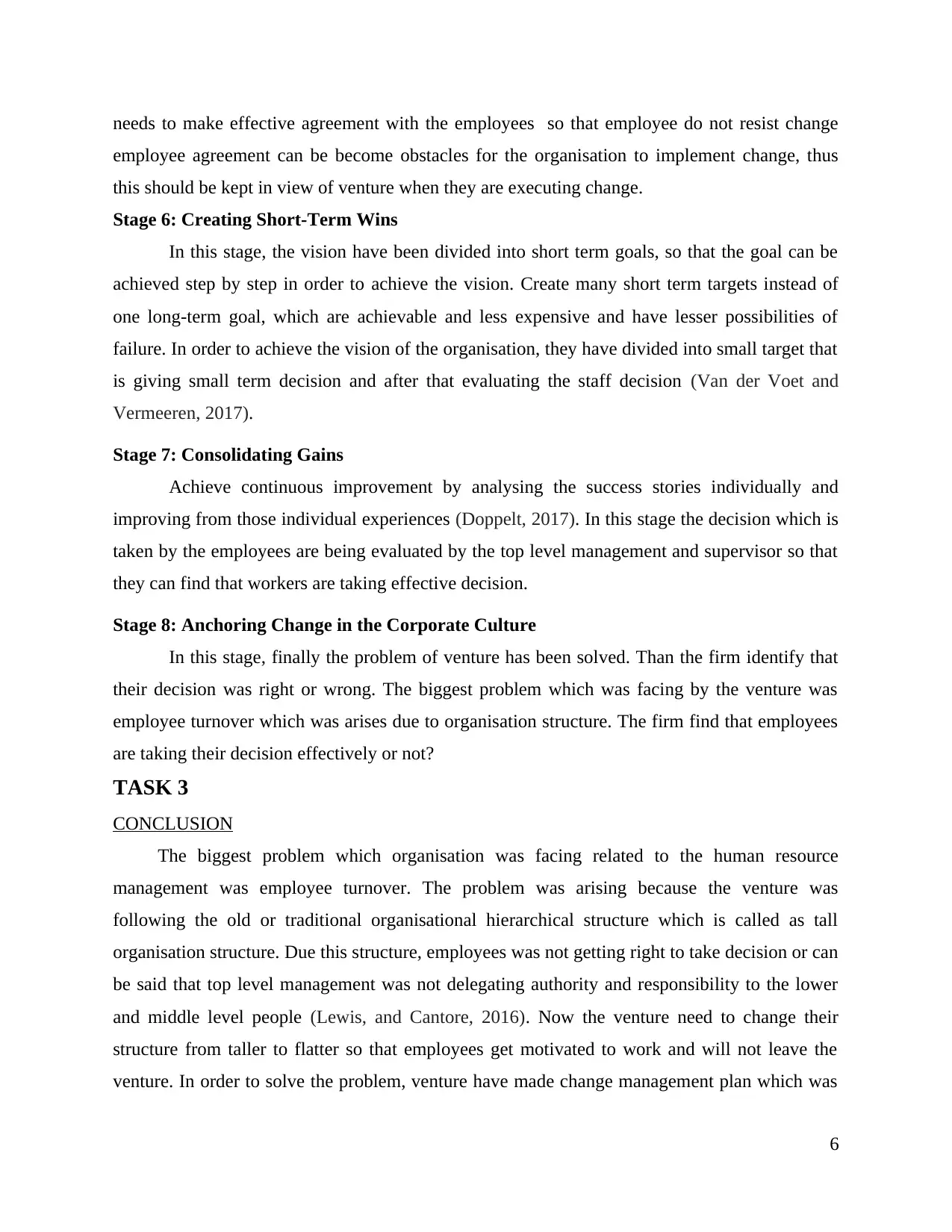
needs to make effective agreement with the employees so that employee do not resist change
employee agreement can be become obstacles for the organisation to implement change, thus
this should be kept in view of venture when they are executing change.
Stage 6: Creating Short-Term Wins
In this stage, the vision have been divided into short term goals, so that the goal can be
achieved step by step in order to achieve the vision. Create many short term targets instead of
one long-term goal, which are achievable and less expensive and have lesser possibilities of
failure. In order to achieve the vision of the organisation, they have divided into small target that
is giving small term decision and after that evaluating the staff decision (Van der Voet and
Vermeeren, 2017).
Stage 7: Consolidating Gains
Achieve continuous improvement by analysing the success stories individually and
improving from those individual experiences (Doppelt, 2017). In this stage the decision which is
taken by the employees are being evaluated by the top level management and supervisor so that
they can find that workers are taking effective decision.
Stage 8: Anchoring Change in the Corporate Culture
In this stage, finally the problem of venture has been solved. Than the firm identify that
their decision was right or wrong. The biggest problem which was facing by the venture was
employee turnover which was arises due to organisation structure. The firm find that employees
are taking their decision effectively or not?
TASK 3
CONCLUSION
The biggest problem which organisation was facing related to the human resource
management was employee turnover. The problem was arising because the venture was
following the old or traditional organisational hierarchical structure which is called as tall
organisation structure. Due this structure, employees was not getting right to take decision or can
be said that top level management was not delegating authority and responsibility to the lower
and middle level people (Lewis, and Cantore, 2016). Now the venture need to change their
structure from taller to flatter so that employees get motivated to work and will not leave the
venture. In order to solve the problem, venture have made change management plan which was
6
employee agreement can be become obstacles for the organisation to implement change, thus
this should be kept in view of venture when they are executing change.
Stage 6: Creating Short-Term Wins
In this stage, the vision have been divided into short term goals, so that the goal can be
achieved step by step in order to achieve the vision. Create many short term targets instead of
one long-term goal, which are achievable and less expensive and have lesser possibilities of
failure. In order to achieve the vision of the organisation, they have divided into small target that
is giving small term decision and after that evaluating the staff decision (Van der Voet and
Vermeeren, 2017).
Stage 7: Consolidating Gains
Achieve continuous improvement by analysing the success stories individually and
improving from those individual experiences (Doppelt, 2017). In this stage the decision which is
taken by the employees are being evaluated by the top level management and supervisor so that
they can find that workers are taking effective decision.
Stage 8: Anchoring Change in the Corporate Culture
In this stage, finally the problem of venture has been solved. Than the firm identify that
their decision was right or wrong. The biggest problem which was facing by the venture was
employee turnover which was arises due to organisation structure. The firm find that employees
are taking their decision effectively or not?
TASK 3
CONCLUSION
The biggest problem which organisation was facing related to the human resource
management was employee turnover. The problem was arising because the venture was
following the old or traditional organisational hierarchical structure which is called as tall
organisation structure. Due this structure, employees was not getting right to take decision or can
be said that top level management was not delegating authority and responsibility to the lower
and middle level people (Lewis, and Cantore, 2016). Now the venture need to change their
structure from taller to flatter so that employees get motivated to work and will not leave the
venture. In order to solve the problem, venture have made change management plan which was
6
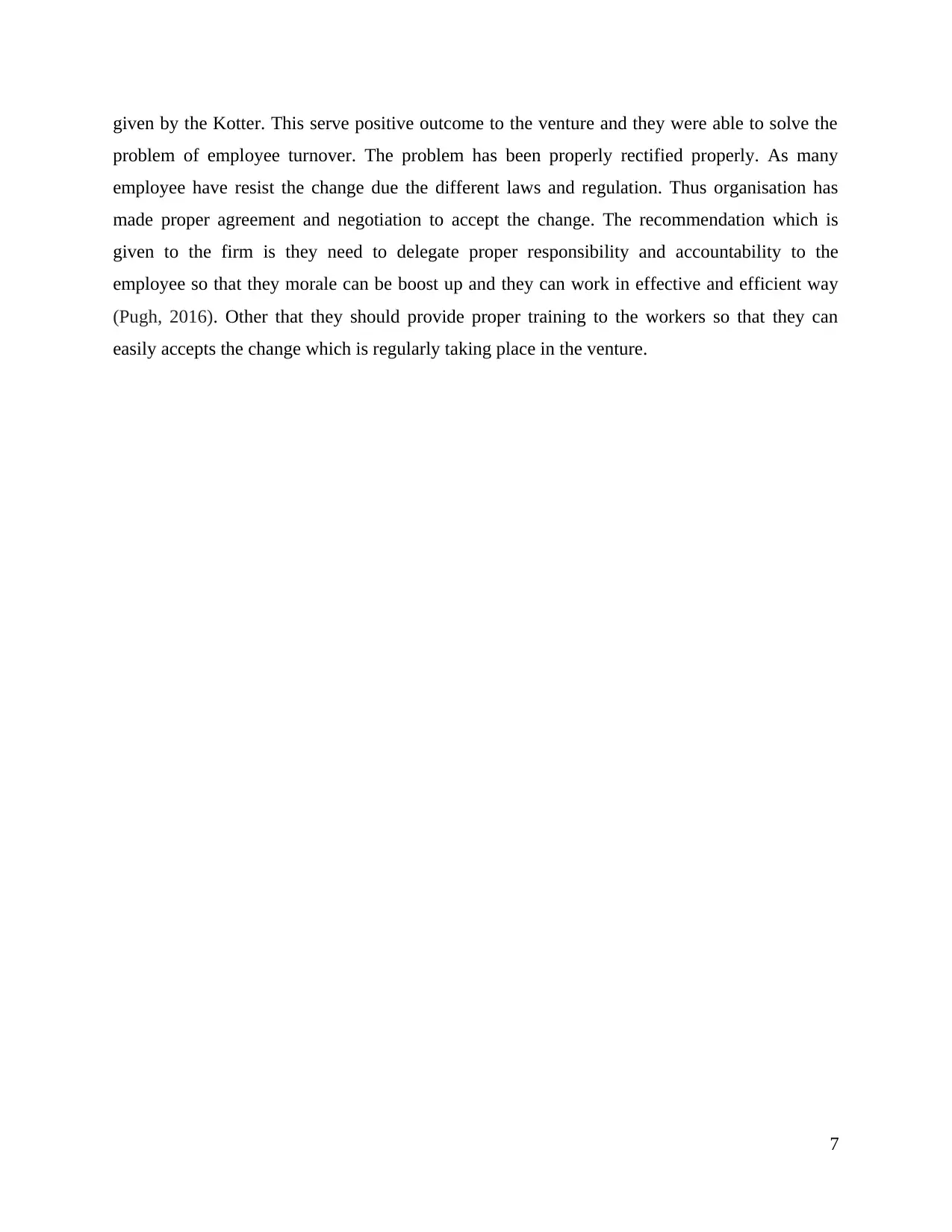
given by the Kotter. This serve positive outcome to the venture and they were able to solve the
problem of employee turnover. The problem has been properly rectified properly. As many
employee have resist the change due the different laws and regulation. Thus organisation has
made proper agreement and negotiation to accept the change. The recommendation which is
given to the firm is they need to delegate proper responsibility and accountability to the
employee so that they morale can be boost up and they can work in effective and efficient way
(Pugh, 2016). Other that they should provide proper training to the workers so that they can
easily accepts the change which is regularly taking place in the venture.
7
problem of employee turnover. The problem has been properly rectified properly. As many
employee have resist the change due the different laws and regulation. Thus organisation has
made proper agreement and negotiation to accept the change. The recommendation which is
given to the firm is they need to delegate proper responsibility and accountability to the
employee so that they morale can be boost up and they can work in effective and efficient way
(Pugh, 2016). Other that they should provide proper training to the workers so that they can
easily accepts the change which is regularly taking place in the venture.
7
⊘ This is a preview!⊘
Do you want full access?
Subscribe today to unlock all pages.

Trusted by 1+ million students worldwide
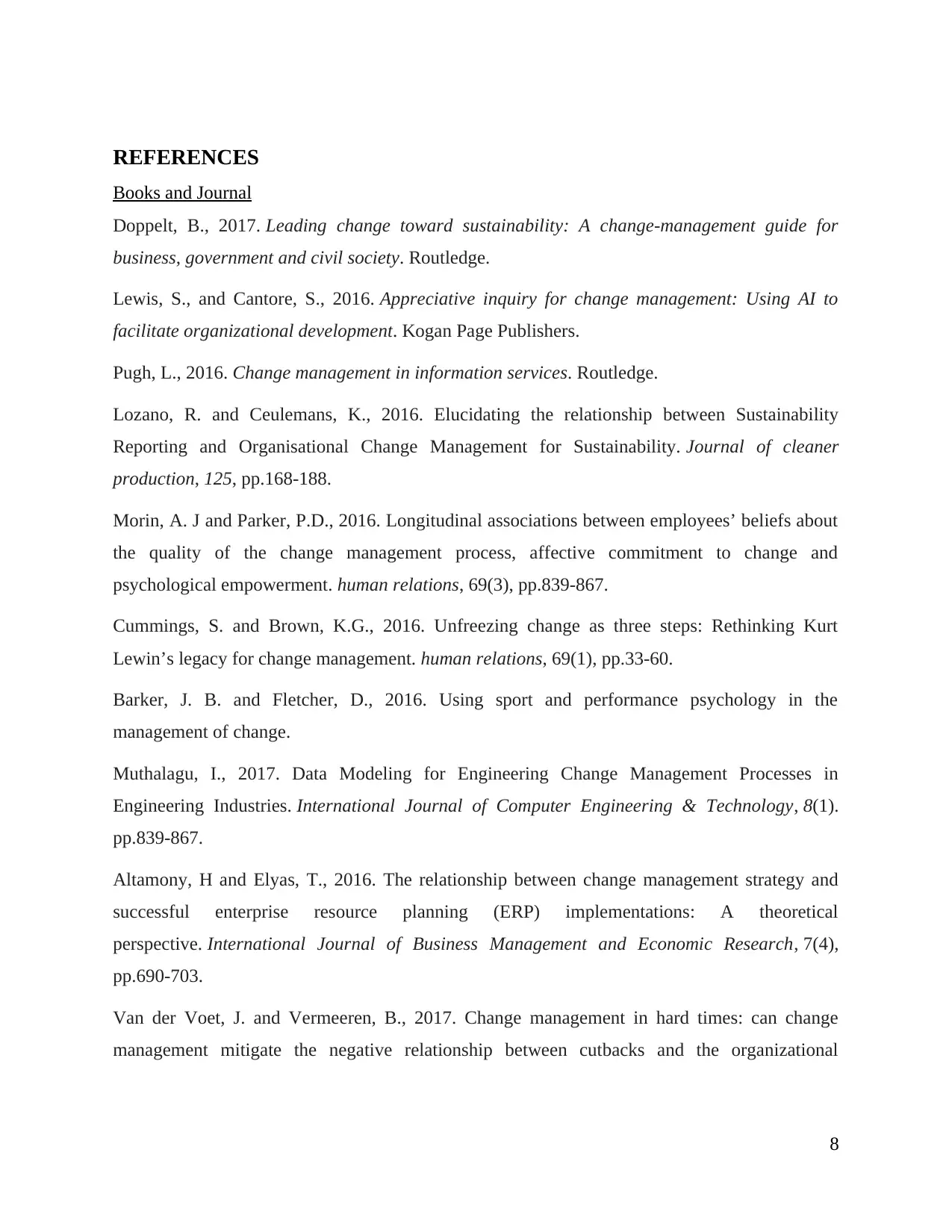
REFERENCES
Books and Journal
Doppelt, B., 2017. Leading change toward sustainability: A change-management guide for
business, government and civil society. Routledge.
Lewis, S., and Cantore, S., 2016. Appreciative inquiry for change management: Using AI to
facilitate organizational development. Kogan Page Publishers.
Pugh, L., 2016. Change management in information services. Routledge.
Lozano, R. and Ceulemans, K., 2016. Elucidating the relationship between Sustainability
Reporting and Organisational Change Management for Sustainability. Journal of cleaner
production, 125, pp.168-188.
Morin, A. J and Parker, P.D., 2016. Longitudinal associations between employees’ beliefs about
the quality of the change management process, affective commitment to change and
psychological empowerment. human relations, 69(3), pp.839-867.
Cummings, S. and Brown, K.G., 2016. Unfreezing change as three steps: Rethinking Kurt
Lewin’s legacy for change management. human relations, 69(1), pp.33-60.
Barker, J. B. and Fletcher, D., 2016. Using sport and performance psychology in the
management of change.
Muthalagu, I., 2017. Data Modeling for Engineering Change Management Processes in
Engineering Industries. International Journal of Computer Engineering & Technology, 8(1).
pp.839-867.
Altamony, H and Elyas, T., 2016. The relationship between change management strategy and
successful enterprise resource planning (ERP) implementations: A theoretical
perspective. International Journal of Business Management and Economic Research, 7(4),
pp.690-703.
Van der Voet, J. and Vermeeren, B., 2017. Change management in hard times: can change
management mitigate the negative relationship between cutbacks and the organizational
8
Books and Journal
Doppelt, B., 2017. Leading change toward sustainability: A change-management guide for
business, government and civil society. Routledge.
Lewis, S., and Cantore, S., 2016. Appreciative inquiry for change management: Using AI to
facilitate organizational development. Kogan Page Publishers.
Pugh, L., 2016. Change management in information services. Routledge.
Lozano, R. and Ceulemans, K., 2016. Elucidating the relationship between Sustainability
Reporting and Organisational Change Management for Sustainability. Journal of cleaner
production, 125, pp.168-188.
Morin, A. J and Parker, P.D., 2016. Longitudinal associations between employees’ beliefs about
the quality of the change management process, affective commitment to change and
psychological empowerment. human relations, 69(3), pp.839-867.
Cummings, S. and Brown, K.G., 2016. Unfreezing change as three steps: Rethinking Kurt
Lewin’s legacy for change management. human relations, 69(1), pp.33-60.
Barker, J. B. and Fletcher, D., 2016. Using sport and performance psychology in the
management of change.
Muthalagu, I., 2017. Data Modeling for Engineering Change Management Processes in
Engineering Industries. International Journal of Computer Engineering & Technology, 8(1).
pp.839-867.
Altamony, H and Elyas, T., 2016. The relationship between change management strategy and
successful enterprise resource planning (ERP) implementations: A theoretical
perspective. International Journal of Business Management and Economic Research, 7(4),
pp.690-703.
Van der Voet, J. and Vermeeren, B., 2017. Change management in hard times: can change
management mitigate the negative relationship between cutbacks and the organizational
8
Paraphrase This Document
Need a fresh take? Get an instant paraphrase of this document with our AI Paraphraser
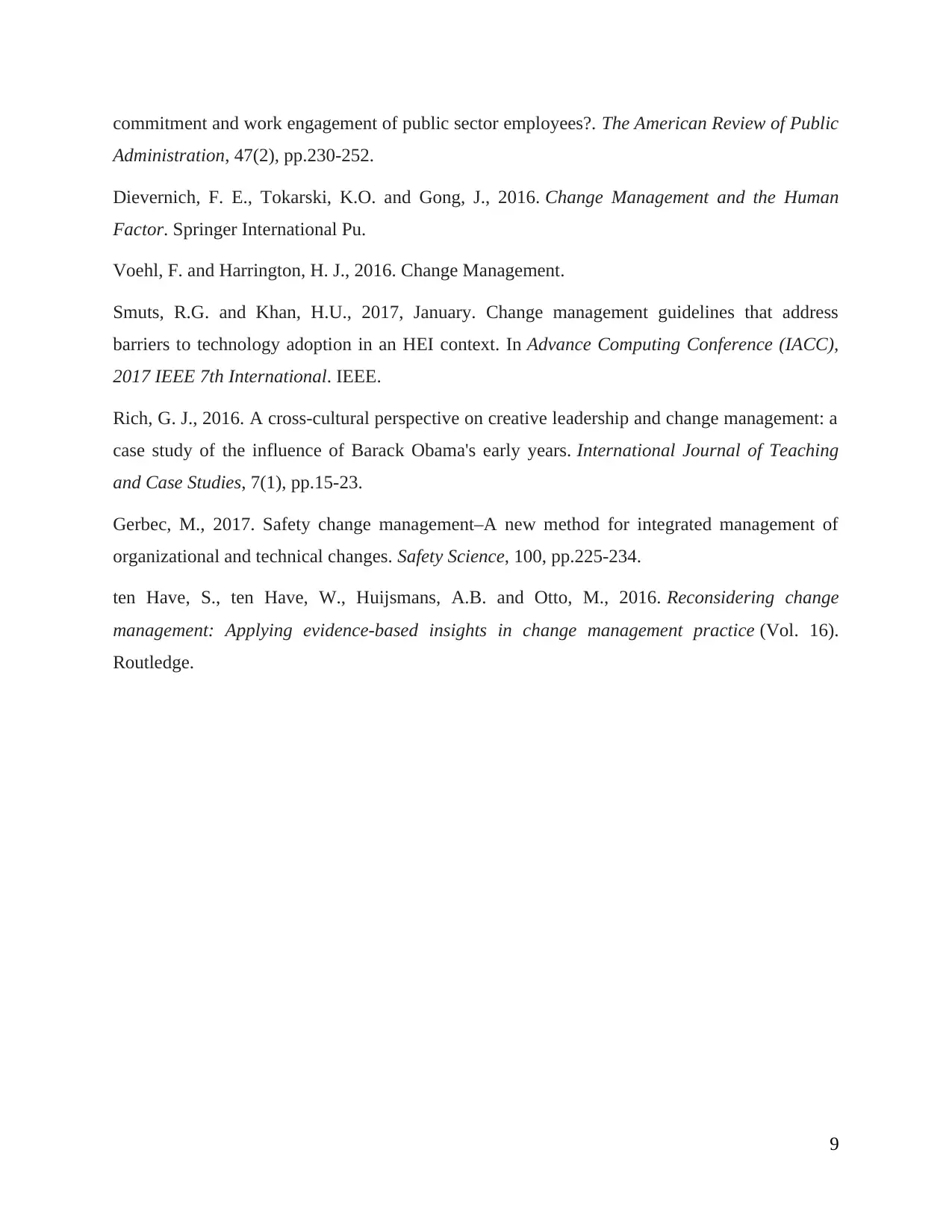
commitment and work engagement of public sector employees?. The American Review of Public
Administration, 47(2), pp.230-252.
Dievernich, F. E., Tokarski, K.O. and Gong, J., 2016. Change Management and the Human
Factor. Springer International Pu.
Voehl, F. and Harrington, H. J., 2016. Change Management.
Smuts, R.G. and Khan, H.U., 2017, January. Change management guidelines that address
barriers to technology adoption in an HEI context. In Advance Computing Conference (IACC),
2017 IEEE 7th International. IEEE.
Rich, G. J., 2016. A cross-cultural perspective on creative leadership and change management: a
case study of the influence of Barack Obama's early years. International Journal of Teaching
and Case Studies, 7(1), pp.15-23.
Gerbec, M., 2017. Safety change management–A new method for integrated management of
organizational and technical changes. Safety Science, 100, pp.225-234.
ten Have, S., ten Have, W., Huijsmans, A.B. and Otto, M., 2016. Reconsidering change
management: Applying evidence-based insights in change management practice (Vol. 16).
Routledge.
9
Administration, 47(2), pp.230-252.
Dievernich, F. E., Tokarski, K.O. and Gong, J., 2016. Change Management and the Human
Factor. Springer International Pu.
Voehl, F. and Harrington, H. J., 2016. Change Management.
Smuts, R.G. and Khan, H.U., 2017, January. Change management guidelines that address
barriers to technology adoption in an HEI context. In Advance Computing Conference (IACC),
2017 IEEE 7th International. IEEE.
Rich, G. J., 2016. A cross-cultural perspective on creative leadership and change management: a
case study of the influence of Barack Obama's early years. International Journal of Teaching
and Case Studies, 7(1), pp.15-23.
Gerbec, M., 2017. Safety change management–A new method for integrated management of
organizational and technical changes. Safety Science, 100, pp.225-234.
ten Have, S., ten Have, W., Huijsmans, A.B. and Otto, M., 2016. Reconsidering change
management: Applying evidence-based insights in change management practice (Vol. 16).
Routledge.
9
1 out of 11
Related Documents
Your All-in-One AI-Powered Toolkit for Academic Success.
+13062052269
info@desklib.com
Available 24*7 on WhatsApp / Email
![[object Object]](/_next/static/media/star-bottom.7253800d.svg)
Unlock your academic potential
Copyright © 2020–2025 A2Z Services. All Rights Reserved. Developed and managed by ZUCOL.




